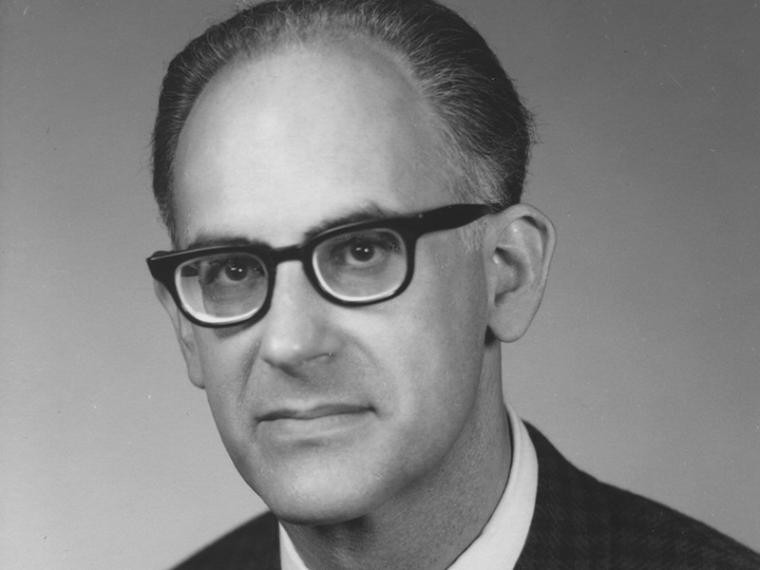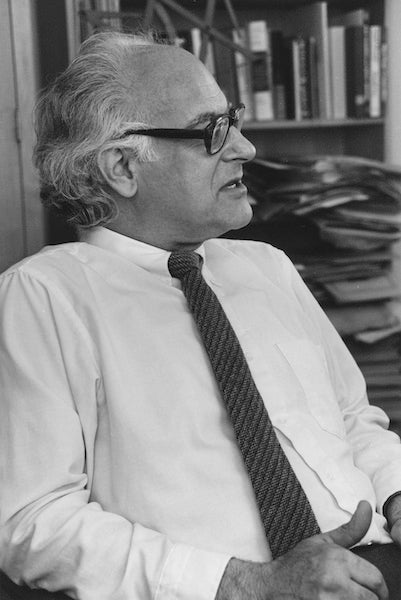Richard Hoffmann, Composer and Protégé of Arnold Schoenberg, Dies at 96
Fifty-year teaching career at Oberlin included annual student trips to his native Vienna.
July 15, 2021
Erich Burnett

Photo credit: courtesy Oberlin College Archives
Richard Hoffmann’s Viennese heritage provided a cherished link to many of the great Western composers. Family ties provided Hoffmann with another crucial link: to one of the 20th century’s most fertile musical minds.
A professor of composition at Oberlin Conservatory for 50 years, Hoffmann imparted his wisdom upon generations of Oberlin students, unwaveringly firm in his approach to his craft—and equally so in his conviction that every composer must chart their own musical course.
Born in 1925, Hoffmann was already a prodigious violinist in his native Vienna by the time the spread of Nazism forced his family to relocate from Austria to New Zealand when he was 10. He completed an undergraduate degree at the University of New Zealand, then arrived in Los Angeles in 1947 to study composition with his cousin, the great serialist composer Arnold Schoenberg. From 1948 to 1951, Hoffmann served as Schoenberg’s secretary and editor, while continuing his postgraduate studies in musicology at the University of California, Los Angeles.
In 1951—the year of Schoenberg’s death—Hoffmann began lecturing in music theory at UCLA. Three years later, he became an assistant professor of composition and music theory at Oberlin, where he remained for the duration of his career.
Hoffmann married Joan Flint ’60 in 1957. That same year, he completed a summer lecture tour of New Zealand that also served as a showcase for his outspoken style. At one point, he railed against the nation’s import restrictions on American records, a condition that resulted in the populace buying readily available British records—thereby placing undue emphasis on British music, in his estimation. He told The Auckland Star at the time that such trends were inappropriately elevating the stature of relatively unknown composers such as Benjamin Britten and Arnold Bax.
“I have no knowledge of popular music,” Hoffmann noted to The Star, calling out the music of Elvis Presley in particular. “I hear it on the radio, but I usually turn it off.”
Though gifted on the violin and proficient at the keyboard, Hoffmann composed almost exclusively without the aid of instruments. He earned acclaim for his Duo for Viola and Cello at the 1956 Darmstadt Festival of Contemporary Music, and subsequently made waves there with his Piano Concerto (1957) and Piano Variations No. 2 (1960). He was a regular contributor to Oberlin’s annual Festival of Contemporary Music, the 1951 creation of then-Dean of the Conservatory David Robertson and an early indicator of Oberlin’s enduring commitment to new music.
Throughout his career, Hoffmann wrote extensively on composers of the Second Viennese School, among them its founder Schoenberg, as well as Anton Webern and Alban Berg. (Of particular interest to Hoffmann was the mysterious shorthand used by Berg in annotated scores of Schoenberg.)
While Oberlin remained his home, Hoffmann frequently took to the road for extended periods, often with his young family in tow. He dedicated a sabbatical leave in the 1960-61 school year to studying and creating electronic music in Vienna, followed by a 1962-63 trip during which he served as one of a team of editors of the first complete edition of Schoenberg’s work, while completing a string trio of his own.
His travels also included a 1970 Guggenheim Fellowship devoted to composing in Berlin, studies toward the critical volume of Schoenberg’s opera Von heute auf morgen (1972), research at the Schoenberg Archives in L.A. (1973), presentation of a paper at the Third International Schoenberg Congress in Vienna (1977), and a second Guggenheim and National Endowment for the Arts awards that supported work in Vienna and Cambridge, Massachusetts (1977-78). By then, Hoffmann’s focus had turned to completing a work for quartet with computer-generated portions that were recorded at the Massachusetts Institute of Technology. The project became his String Quartet No. 4; it was dedicated to Austrian violinist Rudolf Kolisch, a pioneer in the performance of string quartets by Schoenberg and his contemporaries, who died in 1978. The work was performed at the 1984 International Computer Music Conference at the Pompidou Center in Paris.

In the early 1980s, Hoffmann composed and studied in Vienna on sabbaticals, and taught under a Fulbright grant at the Musicological Institute of the University of Vienna, on the topic of serious American music of the 20th century. It was a genre he came to view as all but extinct.
“Serious music, like the church, is finished,” he declared to The Plain Dealer’s Wilma Salisbury in 1992, his words tinged with a measure of his trademark searing wit. “We don’t have an audience for serious music. My hope for the future is that we will have robots rather than audiences. They will be programmed when to applaud. If they don’t like the music, they will walk out and slam the door.”
For many years, Hoffmann led annual student trips to Vienna, where they studied composition and analysis, German language at the Goethe Institute, and visited the graves of masters including Beethoven, Mozart, and Brahms. Initially a Winter Term experience, the trips were expanded by Hoffmann to unfold over a semester, in response to his concern that a period of several weeks was simply not enough time for such immersive study.
“I take the students to Vienna not only for book knowledge, but to get them closer to what music can be,” he told The Plain Dealer. “It’s a tremendous experience for them. It’s lots of fun for me to go back.” Hoffmann spoke to the newspaper from the posh apartment he called home each time he visited Vienna—the same apartment where Schoenberg developed his twelve-tone technique in the 1920s.
Steven Cahn ’81, a former piano major at Oberlin and a professor of music theory at the University of Cincinnati College-Conservatory of Music, was among the students who took part in Hoffmann’s first Winter Term trip to Vienna, in January 1980.
“That was a very powerful experience for me,” Cahn recalls. “For Richard to be in Vienna, it was always a very emotional experience for him, and we were all moved by the things he was moved by.” The trip nurtured Cahn’s own love of Schoenberg, whose music he performed on his senior recital at Oberlin, with guidance from Hoffmann.
“From my cohort, there was a great feeling that Richard did a tremendous amount for us and helped everyone in very meaningful ways,” Cahn says. “He was quite exceptional in caring for his students.”
A self-described maverick, Hoffmann expressed no patience for his colleagues who composed minimalist music, or for those whom he felt harbored insufficient knowledge of the repertoire. He also railed against the incursion of financial factors on the creative process.
“I only write music if I want to,” he said in 1992, in reference to the premiere of one of his works for the Cleveland Chamber Symphony. “I am not interested in writing commissioned pieces for money.” Hoffmann was absent from the premiere performance; he was teaching his Oberlin students in Vienna.
For many years, Hoffmann provided an aesthetic counterpoint to his Oberlin composition colleague Randolph Coleman, an acolyte of John Cage who—unlike Hoffmann’s emphasis on craft—embraced extended discourse about musical concepts and experimentalism. Despite their contrasts, the two composers maintained a deep respect for one another and shared an open-mindedness toward the approaches favored by their students—among them Pulitzer Prize-winner Christopher Rouse ’71, who studied with both professors.
In addition to his early teaching at UCLA and his half-century career at Oberlin, Hoffmann was a visiting professor at the University of California, Berkeley (1965-66), Victoria University (1968), Harvard University (1970), the University of Iowa (1976), and Vienna University (1984). His numerous honors included a Fromm Music Foundation commission (1960), faculty membership in Pi Kappa Lambda (1960), and recognition by the National Institute of Arts and Letters (1966).
Hoffmann retired from Oberlin in 2004, his tenure matching that of influential composition and organ professor George Whitfield Andrews (1883-1932) as the longest in the conservatory’s 155-year history. In retirement, Hoffmann continued to live less than a mile away from campus, in the home he had built in 1964 almost entirely out of aluminum, from its heavily insulated walls to its bathroom cabinets. The design dovetailed with his long-held fascination with Europe’s influential architecture trends of the 1920s and ’30s.
Despite the close proximity, his interactions with the conservatory were few. He contented himself with regular lunches in downtown Oberlin with his contemporaries, a revolving cast that invariably included Coleman and Emeritus Professor of Conducting John Knight. To others, they represented a window into the very history of music itself.
“Richard’s students saw him as an authentic connection to the world of modern Europe—its aesthetics and ethics—and as someone who could see through facades and get to the essence of things,” says Cahn.
Not even Hoffmann himself was spared. “When he turned 90,” Cahn adds, “my wife asked him how he came by all this energy he had, to which he responded: 'It’s all fake.'”
Hoffmann died June 24, 2021. He was 96. He is survived by a son, Peter, and by a daughter, Anna, Oberlin Conservatory’s longtime manager of Summer Programs. He was preceded in death by his wife and his son Paul.
Hoffmann's archive of letters, musical scores, recordings, and other communications will be housed at the Exilarte Center in Vienna.
You may also like…
Josh Nolan Named Vice President, General Counsel, and Secretary at Oberlin
Distinguished attorney brings extensive experience in higher education law.
Learning by Teaching: Oberlin Students Share Global Music with Young Learners
College and Conservatory students in PACE 103 prepare local children for an immersive community concert at Oberlin.
Nuiko Wadden ’02 Joins Oberlin Conservatory Faculty as Assistant Professor of Harp
The versatile musician brings extensive opera, orchestral, and contemporary music experience to her role


